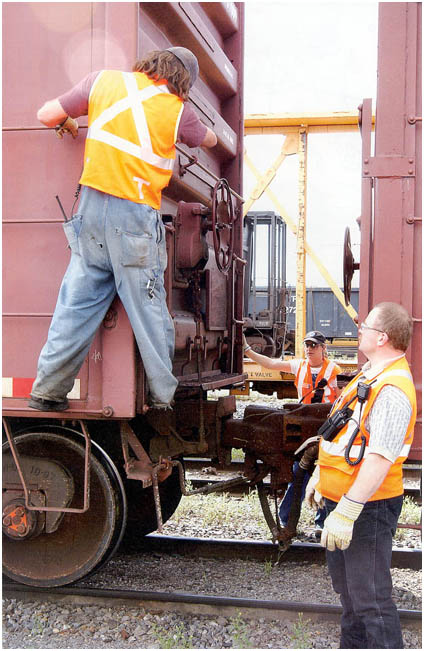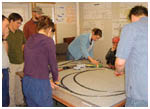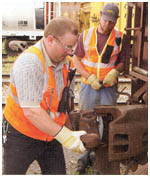|
Fall
2004

Canadian
Pacific Railway Employee Communications
Room 500 401-9th Ave S.W. Calgary AB T2P
4Z4
Hands-On
Training

Secure hand and
foot hold: Dustin Southgate, associate instructor, rules - relief, gives
trainman (yard) Jason Smith instructions for properly accessing a brake wheel on a
rail car.
In recent
years, with traffic volumes rising and many workers approaching retirement age, the
railway has placed an increased emphasis on training and hiring new running trades
employees.
From that first exposure to rail life, we're looking for recruits with a healthy,
positive attitude, an ability to work safely with others, and an intimate knowledge
of best practices in an industry where an error in judgement can lead to a fatality.
| |

Not kids stuff: Trainees learn
the ins and outs of safety in the railway environment. From left, Todd White,
Ken Perkins, Jason Shulist, Tamara Hynd, Megan Haley (adjusting the train),
Bobby Botterill and Bernie Plant.
|
"We want our students to begin with consistent, safe practices as laid out by
CROR (Canadian Railway Operating Rules) and our safety manual", said Kim Price,
CPR field placement officer - relief. "That way, when they see things which are
being done contrary to the rules, they will correct the situation and do things the
right way".
Traditionally, training has consisted of both classroom and practical work, with
each week of theory being reinforced with two to three weeks out on the property
under the supervision of "coaches" who evaluate the students and qualify
them. The balance of practical work with theory is critical.
Increasingly, the trainers are giving even more attention to the
hands-on aspects of learning.
"We've developed what we call our "training train" as a development
tool", Kim said. "It consists of a few cars that we bring to an industrial
siding or some place in the yard that's quiet. Students get to familiarize themselves
with tasks they may not get a chance to do otherwise - such as changing knuckles
(part of the coupler) or air hoses.
"It's one way we're implementing best practices in the Alberta Service Area
that need to be in place across the board".
In the B.C. interior, where Bernie Plant also works as a CPR field placement officer
- relief, the training staff pursues similar goals. "We take the classes out in
the field for a couple of days and work on one or two tasks - entraining,
detraining, changing knuckles and hoses, applying brakes. Then, when they are
comfortable with those things they can go out with their coaches and perform them
with confidence".
For Bernie, too, it's a matter of giving students as much hands-on
time as possible. "I've built a model train set with central traffic control,
a yard, cautionary limits, interlockings, railway crossings at grade and double
track", he said. "The students use this to get an overview of just about
anything and everything they might encounter in the field. Mistakes with the model
don't injure anyone and don't run up expenses for the
company.
| |

Dustin Southgate, associate
instructor, rules - relief, shows trainman (yard) Jason Smith how to change a
knuckle.
|
"Also, near the end of the training period, we get the students to work the
yard in pairs, with the regular crew members, or coaches, sitting back and letting
the trainees do everything themselves. This really shows both the trainers and the
coaches how the students are doing - there's no faking it or riding on the coaches'
coattails".
Few things at the railway are more important than the implementation of best
practices. Lives are at stake, and so is the future of our operations.
"A lot of heart and soul goes into training", Kim says. "We really
believe in what we're doing and the quality of the work". It's a cooperative
effort that puts people first. "Attitude is everything", Bernie says.
"The local trainers are very involved with human resources and local operations
managers. We all have a major interest in who gets hired. We must never forget it's
the people that make CPR what it is".
This CP Rail News article is copyright 2005 by
Canadian Pacific Railway and is reprinted here with their permission. All
photographs, logos, and trademarks are the property of the Canadian
Pacific Railway Company.
|